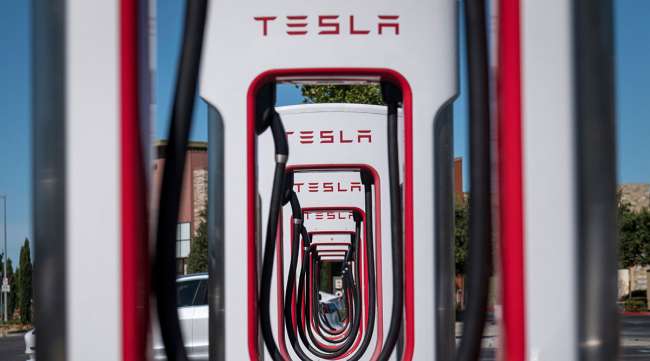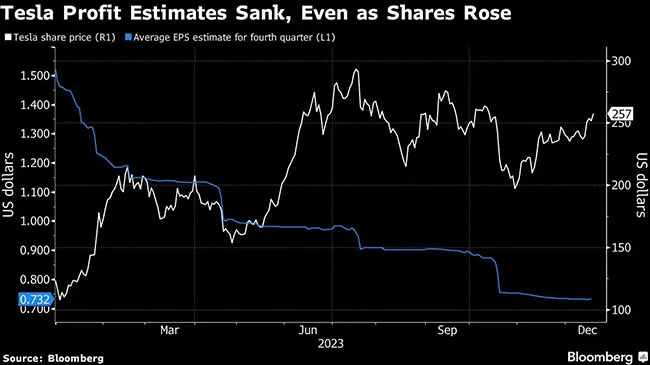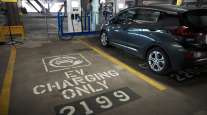Tesla Analysts Eyeing EV Slowdown Turn More Cautious on 2024

[Stay on top of transportation news: Get TTNews in your inbox.]
Wall Street’s outlook on Tesla Inc. is darkening rapidly, with at least two analysts turning more cautious on the electric vehicle maker in as many days.
Some of the EVs made by Tesla may no longer qualify for government subsidies in the U.S. and in some European countries in 2024, putting further pressure on the company’s revenue at a time when demand for these cars is already slated to slow, the analysts said. “The loss of these incentives may further the risk of additional price cuts if Tesla continues to push for growth next year,” Matt Portillo, an analyst at Tudor, Pickering, Holt & Co., wrote in a note Dec. 19. Portillo also expects Tesla’s deliveries for the last three months of 2023 to miss average analysts’ expectations.
The latest glum comments from analysts add to a broader trend of Wall Street’s worsening view on Tesla’s results. Analysts’ average fourth-quarter profit forecasts for the company are now down over 55% from where they were 12 months back, while 2024 profit expectations have sunk 43% over the same period, according to data compiled by Bloomberg.
For sales, analysts on average expect the Elon Musk-led automaker to deliver more than 481,000 EVs in the quarter ending Dec. 31, according to Bloomberg data. Portillo — who has a sell recommendation on the stock — expects that number to be around 470,000 units. RBC Capital Markets analyst Tom Narayan — who has the equivalent of a buy rating on Tesla — expects deliveries of around 476,000 cars.

On Dec. 18, Narayan lowered his delivery estimates on Tesla for 2024 and 2025, to reflect “more modest growth” for Model 3 and Model Y sales, noting headwinds that include increased competition and the loss of federal incentives. Some variants of Tesla’s mass-market Model 3 cars are set to lose the full federal tax credit next year, Narayan said.
The company may face similar issues in France and Germany, Tudor’s Portillo said. These subsidy troubles will come on top of an industrywide slowdown in EV demand that is now widely expected after Tesla first waved the red flag during its third-quarter results in October.
Those warnings were followed by a flood of similar dire forecast on EVs from legacy car companies such as General Motors Co. and Ford Motor Co., rental-car company Hertz Global Holdings Inc., as well as several EV suppliers.
A large part of the wider EV weakness is because the group of enthusiastic first-adopters who eagerly buy into new technologies has possibly been exhausted, while mainstream buyers stay wary of the high prices and the still-nascent EV ecosystem.
Want more news? Listen to today's daily briefing above or go here for more info
“The average new EV price has fallen about 21% since 2022, yet consumers remain timid when it comes to making the jump, with most citing battery reliability, the lack of available public charging stations, and the time required to fully charge as key mental and physical hurdles they’re unable to overcome,” Cowen analyst Jeffrey Osborne wrote in a note to clients Dec. 19.
As a result, profit and revenue estimates on Tesla — which only sells EVs — have been dropping. Portillo and Narayan are not the only analysts who are worried about next year.
On Dec 15, Deutsche Bank analyst Emmanuel Rosner said the “larger risk” for Tesla was that both growth and earnings for 2024 may miss expectations amid slower EV adoption rate.
Tesla shares were up as much as 1.9% Dec. 19, bringing its year-to-date advances to 108%. But the stock’s performance this quarter has been dismal, reflecting the deteriorating outlook for EV adoption in 2024. Tesla has risen about 2% since end of September, compared with the broader S&P 500 Index’s 11.5% total returns.




